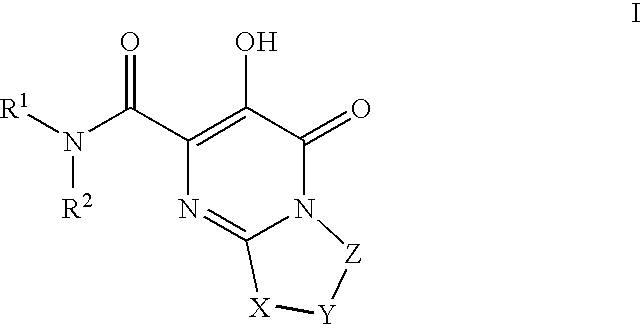HIV integrase inhibitors
a technology of integrase inhibitors and hives, which is applied in the direction of biocide, heterocyclic compound active ingredients, drug compositions, etc., can solve the problems of large number of patients who fail to respond to this therapy and not all patients are responsiv
- Summary
- Abstract
- Description
- Claims
- Application Information
AI Technical Summary
Benefits of technology
Problems solved by technology
Method used
Image
Examples
example 1
[0240]
[0241]1-(N,N-Dimethylsulfamoyl)-N-(4-fluoro-2-(1H-1,2,4-triazol-1-yl)benzyl)-3′-hydroxy-4′-oxo-6′,7′-dihydro-4′H-spiro[piperidine-4,9′-pyrimido[2,1-c][1,4]oxazine]-2′-carboxamide. To a mixture of Intermediate 18 (0.042 g, 0.10 mmol) in DMF / EtOH (2 mL, 1:1) was added triethylamine (0.045 mL, 0.32 mmol) and (4-fluoro-2-(1H-1,2,4-triazol-1-yl)phenyl)methanamine HCl salt (prepared using procedure reported by Naidu, B. N. et al in U.S. Pat. No. 7,557,447, 0.04 g 0.20 mmol). The resulting mixture was stirred at 80° C. for 3 days and concentrated. The residue was triturated with hot MeOH and filtered to give the title compound as white solid (0.0238 g, 42% yield). 1H NMR (500 MHz, CDCl3) δ: 12.05 (1H, s), 8.83 (1H, t, J=6.6 Hz), 8.43 (2H, s), 7.67 (1H, dd, J=8.4, 5.9 Hz), 7.17 (1H, td, J=8.2, 2.6 Hz), 7.07 (1H, dd, J=8.4, 2.6 Hz), 4.42 (2H, d, J=6.6 Hz), 3.98 (4H, s), 3.68 (2H, dd, J=12.6, 1.6 Hz), 3.18 (2H, td, J=12.8, 1.9 Hz), 2.81 (6H, s), 2.36 (2H, td, J=13.4, 4.8 Hz), 1.89 (2H, ...
example 25
[0244]
[0245]1-(5-Fluoro-2-methylphenylsulfonyl)-3′-hydroxy-N-methyl-4′-oxo-6′,7′-dihydro-4′H-spiro[piperidine-4,9′-pyrimido[2,1-c][1,4]oxazine]-2′-carboxamide. A solution of intermediate 56(0.056 g, 0.10 mmol) in 2 M CH3NH2 in MeOH (3 mL) was heated at 70 C for 18 h in a sealed vial. Then, cooled and purified by preparative HPLC to afford product as white solid (0.0464 g, 67%). 1H NMR (500 MHz, CDCl3) δ: 12.26 (1H, s), 7.58 (1H, dd, J=8.6, 2.8 Hz), 7.48 (1H, br s), 7.31 (1H, dd, J=8.4, 5.3 Hz), 7.18 (1H, td, J=8.1, 2.8 Hz), 4.02-3.95 (4H, m), 3.80-3.75 (2H, m), 3.05 (3H, d, J=4.9 Hz), 3.01-2.94 (2H, m), 2.60 (3H, s), 2.37 (2H, td, J=13.4, 4.3 Hz), 1.99-1.94 (2H, m), HRMS (M+H) calcd for C20H24FN4O6S: 467.1401; found: 467.1403.
[0246]
[0247]N-(4-Fluoro-2-(5-methyl-1H-1,2,4-triazol-1-yl)benzyl)-3′-hydroxy-4′-oxo-6′,7′-dihydro-4′H-spiro[piperidine-4,9′-pyrimido[2,1-c][1,4]oxazine]-2′-carboxamide. A solution of Example 23 (0.65 g, 1.88 mmol) in EtOAc (30 mL), EtOH (8 mL) and 1N HCl (2 mL,...
example 26
[0252]
[0253]Methyl 2-(2′-(4-fluoro-2-(5-methyl-1H-1,2,4-triazol-1-yl)benzylcarbamoyl)-3′-hydroxy-4′-oxo-6′,7′-dihydro-4′H-spiro[piperidine-4,9′-pyrimido[2,1-c][1,4]oxazine]-1-yl)-2-oxoacetate. To a mixture of Intermediate 65 (0.135 g, 0.27 mmol) suspended in CH2Cl2 (2 mL) was added diisopropylethylamine (0.14 mL, 0.81 mmol) followed by methyl chlorooxoacetate (0.05 mL, 0.54 mmol). The resulting mixture was stirred at room temp for 18 h. and concentrated. Purification (YMC Combiprep ODS-A, 30 mm×50 mm, MeOH / H2O / 0.1% TFA) yielded the title compound as lavender solid (0.686 g, 45% yield). 1H NMR (500 MHz, CDCl3) δ: 11.91 (1H, bs), 8.34-8.33 (2H, m), 7.72-7.70 (1H, m), 7.30-7.27 (1H, m), 7.05-7.04 (1H, m), 4.49 (2H, d, J=11.6 Hz), 4.05 (4H, s), 3.92 (3H, s), 3.68 (1H, d, J=12.8 Hz), 3.53-3.49 (2H, m), 3.1-3.05 (1H, m), 3.56 (3H, s), 2.29-2.21 (2H, m), 2.02-2.00 (2H, m). HRMS (M+H) calcd for C25H27FN7O7: 556.1956; found: 556.1951.
PUM
| Property | Measurement | Unit |
|---|---|---|
| wt % | aaaaa | aaaaa |
| temperature | aaaaa | aaaaa |
| temperature | aaaaa | aaaaa |
Abstract
Description
Claims
Application Information
 Login to View More
Login to View More - R&D
- Intellectual Property
- Life Sciences
- Materials
- Tech Scout
- Unparalleled Data Quality
- Higher Quality Content
- 60% Fewer Hallucinations
Browse by: Latest US Patents, China's latest patents, Technical Efficacy Thesaurus, Application Domain, Technology Topic, Popular Technical Reports.
© 2025 PatSnap. All rights reserved.Legal|Privacy policy|Modern Slavery Act Transparency Statement|Sitemap|About US| Contact US: help@patsnap.com



